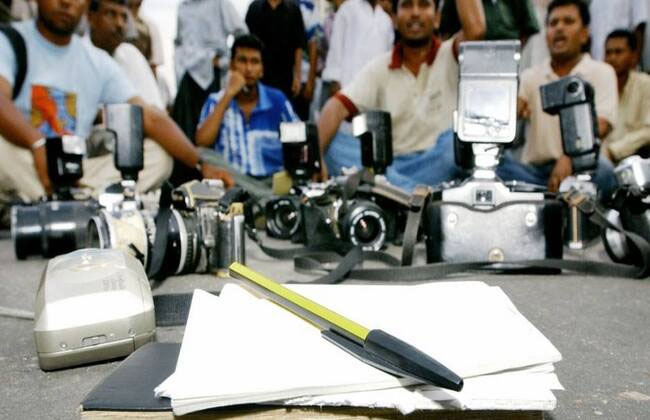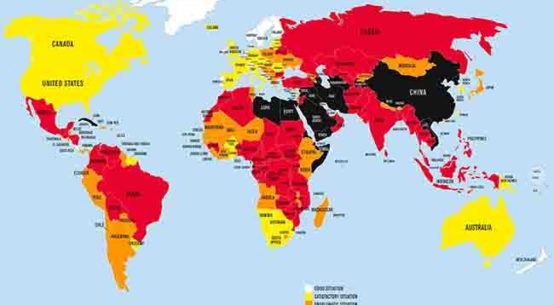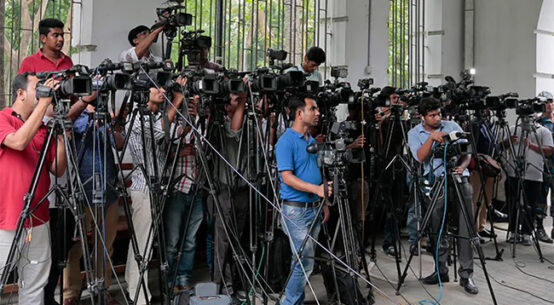
Bangladesh media continues to live in semi-denial as it goes through transition and the so-called professional media faces increasing pressure from many forces particularly social media. This shift of focus from the professional to the individual/social space is historically significant. For the first time, the media has become a shared space.
Its implications are many and at all levels. For professional media, the threat is deep as it affects the economic viability of the construct. But its livelihood factor makes the question go much beyond media production issues. It has in many cases questions if the age of conventional media is slowly fading away or not and a sort of extinction looms.
Broadcast and print media dynamics
Technology has changed media and access which created new opportunities but also challenges. Information gathering and distribution was greatly facilitated by technology which included the rise of radio and later TV. However, the consumers were dominantly the urban middle class and ownership was the upper segment.
Traditional print media held sway even after broadcast media arrived which were initially government owned but that also meant that literacy and proximity to the ruling class was key for its survival. Radio always had a wider reach but the middle class was reliant on print media. As broadcast media was official, others had no way to have their say on any matters except in print media. Hence the linkage between socio-politics and print media was set early on. But the fact remained that broadcast was reaching more people while print was limited to a particular class, though the one that mattered a lot once.
As the market expanded, new products emerged and the broadcast channels began to be more prominent as their reach was much higher and visual media was more popular. That meant more influence without depending on other factors like literacy. Wealth also increased in societies and the private sector began to explore the possibilities in media, particularly broadcasting.
The rise of digital media
From the 60s onwards this global transition began which by the 80s had made TV supreme and print media was facing high pressure. It was perhaps less so in the South as TVs were expensive but cheaper TVs began to change life as information and entertainment both had a better chance of doing better on A-V platforms. Print was more respectable but lesser in reach. Obviously, as the world gained greater purchasing capacity, media investment and production began to change including the kind of influence and profit each carried. It also offered more profit.
As globalization became the new market, replacing older protected and exclusive ones, the 80s saw the arrival of the internet which changed the media world more dramatically in history than ever before. The opportunities were enormous as each person began to consume more and marketing needs were thus greater. It was only a matter of time before products could be pitched to each individual to generate new demands and satisfy regular ones.
The market could reach individuals more effectively than ever before and thus social media was inevitable as the new tool of individual and collective access. But the difference with the past was the role of the consumer as a player in the market as well through the use of social media.
Media content and social media as competitor
Social media created many marketing opportunities but while the producer became more powerful, the existence of the consumer was first directly felt and the dual role became obvious. Another part was that while commodities were produced by professional outfits, the situation was different when it came to media products. The producer –professional media – suddenly faced a competitor from the oddest of the space, the consumer, and thus the advantages were reduced for professional media by social media.
Taking social media as a whole, millions and even billions were involved as both producers and consumers and became the greatest competitor of them all. Prior to that website based online media had already shown how media was changing and what new media looked like. Thus the monopoly of professional media was broken. It was as much economic as socio-political. The border between pro and social media was also significantly erased. The world continues to negotiate with this new media reality today and it changes every day.
Bangladesh and the new media scene
The division between broadcast media and print media is also prominent. Broadcast has a much higher level of investment but also advertisement reach so it has coped better. Its linkage with social media is better and can broadcast on that platform as well. The production investment is much higher and the AV media competition is less from social media than it is for print media.
Bangladesh print-media has several more challenges apart from the ones mentioned above which deeply constraints it. It’s not just versus social media but they lie within pro- media as well. The most important is that political partisanship determines critical support through official adverts which are the mainstay of most print media. This means print media can’t play robustly and remain economically viable. Broadcast media is also operating in a semi saturated market and also has to jostle with consumer cultures that are fond of partisan journalism rather than objective media.
One of the reasons why social media is so popular in Bangladesh is because one can be both abusive and biased and yet get large followings. In a way, hate media is very popular in Bangladesh and critical thinking is not popular. This creates a new media situation in terms of content where production of exclusive stuff on social media is now possible, reach is now guaranteed and bias is a positive determinant for popularity.
Basically, these are not great days for print media in general. It has not changed its profile much and can’t so it remains the media of choice of the less socio-politically biased consumer. The problem is that the market for such media has shrunk or never grown and the number of outlets has made the path more difficult to walk on. It also has seen the decline of the middle class as a socio-political mediating class.
Innovation is the way out
The market of print and other media does differ. Though most print now have clones on social media that is a whole different process of media production and involves investment that is not competitively profitable. It means becoming a niche media could be the only way for them. Print has to accept that its glory days are over but its significant days are not. It can offer reflective , rational media which social media can’t and AV media can offer less.
The kind of instant, short attention span media which online and social media generates is not what print can do and compete. It has to be quality media and at the end of the day, many who matter will seek out quality over the mass and social media products.
Print media therefore has to go where the calmer section of the market lives. The sensational will not be ignored but it can never compete with social media driven content that way. So it’s a reflective space that print media can occupy best.
The funding issue will remain but the demand for objective facts and opinion remains though not at amass level. Like many international media units, Bangladeshi print media can seek supporters and sponsors, particularly at the retail level. Social media reliant pro-media are also attractive to investors who seek prestige and clout rather than quality media so seeking sponsors and donations –individual and corporate – who seek prestige but through quality should be part of the new market economics.
Print media, the most quality part of media as a whole is at bay and can’t deal with life with a business as usual approach. It has to innovate and practice new strategies and look for new markets which are obviously going to be niche, both supporter and consumer wise. This segment exists as they do in all markets and needs to be connected. To survive and flourish, print media can’t stand still.
(Republished from The News Times )
Afsan Chowdhury is a Bangladeshi journalist, columnist and liberation war researcher. He received Bangla Academy Award in the year 2018 for his contribution to the liberation war literature.




